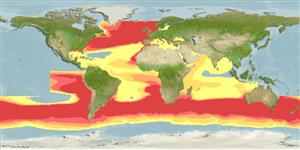Preferred temperature (Referencia
123201): 6.7 - 23.9, mean 11.8 °C (based on 5684 cells).
Phylogenetic diversity index (Referencia
82804): PD
50 = 0.5039 [Uniqueness, from 0.5 = low to 2.0 = high].
Bayesian length-weight: a=0.01148 (0.00633 - 0.02083), b=3.01 (2.84 - 3.18), in cm total length, based on LWR estimates for this species & (Sub)family-body (Ref.
93245).
Nivel trófico (Referencia
69278): 4.1 ±0.64 se; based on food items.
Resiliencia (Referencia
120179): Bajo, población duplicada en un tiempo mínimo de 4.5-14 años (Assuming tm>4).
Fishing Vulnerability (Ref.
59153): High vulnerability (60 of 100).
🛈
Climate Vulnerability (Ref.
125649): Moderate vulnerability (38 of 100).
🛈
Nutrients (Ref.
124155): Calcium = 14 [5, 56] mg/100g; Iron = 0.476 [0.182, 1.625] mg/100g; Protein = 20 [18, 22] %; Omega3 = 0.322 [0.177, 0.578] g/100g; Selenium = 41.9 [19.0, 86.8] μg/100g; VitaminA = 11.8 [2.8, 48.3] μg/100g; Zinc = 0.397 [0.210, 0.866] mg/100g (wet weight); based on
nutrient studies. 